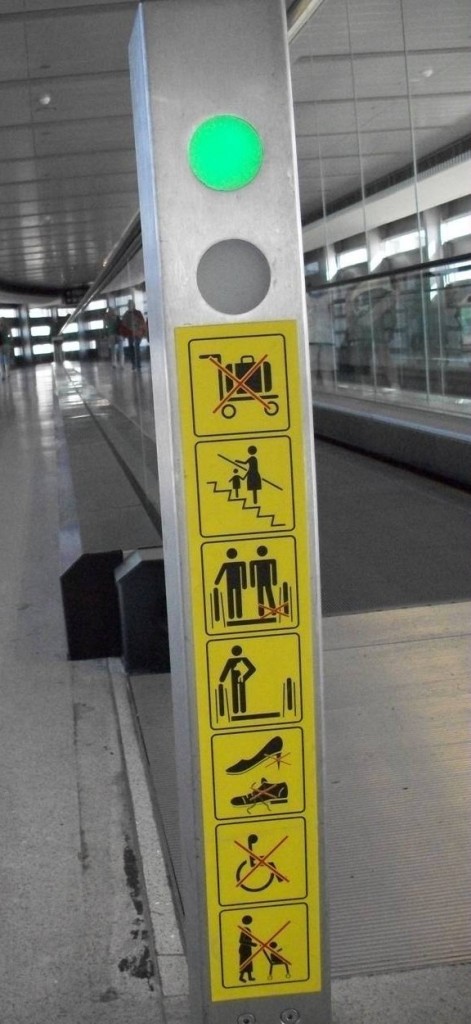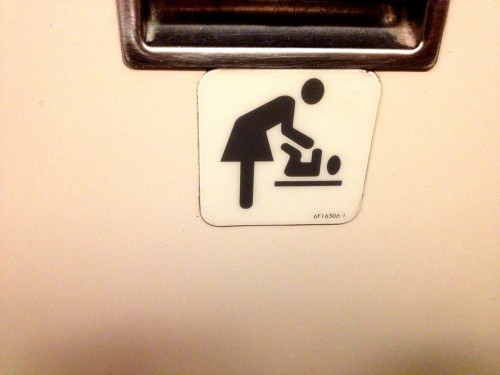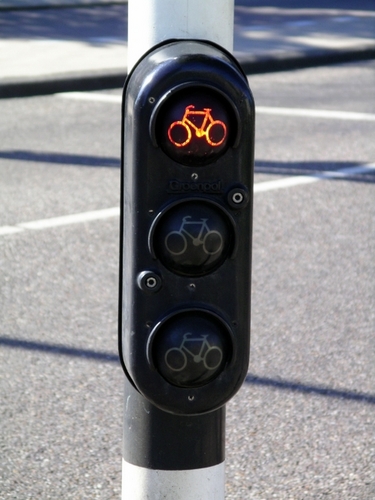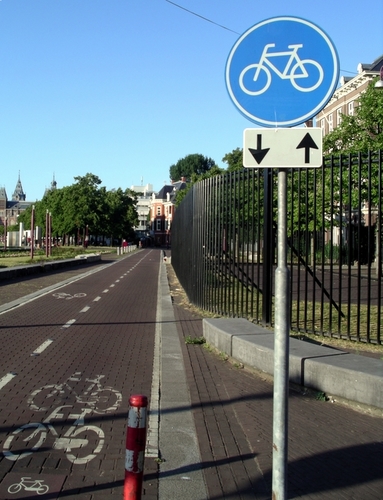Following up on our recent posts on representations of “person”, I discovered a set of stick figures from around the world, collected by Steve Portigal. He has some observations on variations. From a gender perspective, however, they all look more or less like this one from Bali, Indonesia:

What is interesting for our purposes, though, is this Chinese language example from Bangkok, Thailand:

Do you see it? In case you doubted it, the fact that the fourth panel includes a stick figure in a skirt (1) proves that the non-skirted stick figures are implicitly men and, on an entirely different note, (2) reminds us that men do not take care of children.
Similarly, these two pictures of warning signs for moving sidewalks (snapped in the Dublin airport) feature “neutral” stick figures, unless a child is involved:


We see the same phenomenon in commercial airplanes, where “flight attendants” still tend to be pictured in skirts.
Prof. Shaun Huston sent in these photos from United Airlines. Everyone’s in pants… except the person changing a diaper:
Amanda C. sent in another example from a hotel in Sydney. When the stick figures are housekeepers, suddenly they sprout skirts!
Sophie pointed out that in Holland, bike traffic lights only include images of what most people would recognize as a “men’s” bike, with the bar across the top, thereby managing to gender the traffic signals without including any figures of people at all (images found here and here):
For what it’s worth, here’s a counter-example from Malmö, Sweden:

Emanuelle, who took the photo and submitted it, says it’s the only time she can remember that she’s seen a silhouette figure like this with a kid where the figure isn’t clearly marked as female. We’ve a fun collection of traffic lights featuring female stick figures.
We’d love to collect more examples!
Lisa Wade, PhD is an Associate Professor at Tulane University. She is the author of American Hookup, a book about college sexual culture; a textbook about gender; and a forthcoming introductory text: Terrible Magnificent Sociology. You can follow her on Twitter and Instagram.






Comments 100
eric — May 18, 2009
The obvious gender-typing aside, the picture in the 4th frame also seems to convey the message "Grasp your child by the neck and suffocate it" more than "Take care of children".
eloriane — May 18, 2009
I've seen signs just like that second one on most of the escalators I've ridden, all over the US. If there's a note about children, the stick figure always suddenly acquires a skirt. It's always been low-level infuriating. I should take pictures of them in future.
Toni — May 18, 2009
I've noticed the same sort of assumptions in the UK - for example, many supermarkets have some parking spaces reserved for parents with small children, which are marked by a symbol of an adult and child. Sometimes the adult is relatively gender neutral, but most of the time it's clearly supposed to be female i.e. wearing a skirt or dress (and that's without getting into Iceland's patronising tagline 'Mums are heroes!').
Rachel_in_WY — May 18, 2009
I always thought the sign that you see all along all the highways in San Diego that warn you of possible pedestrians in the roadway was strange. Again, the mother is holding the child's hand, and the child's feet aren't even touching the ground because her mother is yanking her along so fast. Also, the child seems to have very large boobs for a kid her size.
Umlud — May 18, 2009
I'm personally offended that it supposes that men are incapable of riding escalators without causing problems to themselves or the mechanism.
I'm also a little curious as to why a sign from Thailand would be written in Chinese and English... I mean Thailand does use its own language. More context please! Remember, just because more than a billion people speak and write some form of Chinese, painting "Asia" as pan-Chinese is another annoying thing that I - as a non-Chinese Asian - have to deal with.
If you're going to point out problems with gender personifications from around the world, at least get those parts of the world a little more accurate, or provide explanation as to why observed does not match expected (in this case why there is no Thai when the sign is from Thailand).
Lisa Wade, PhD — May 18, 2009
Umlud,
I don't know the answer to your question as to why Chinese languge on a Thai sign. I took the picture from the link. Perhaps you could ask your question to the original photographer, Steve Portigal. Sorry I can't be of more help.
Duran — May 18, 2009
You guys are so quick to take offense at perceived slights to "protected" groups.
What I took from that set of images was the implication that men are more likely to act dangerously and stupidly, such standing near the edge, or not grasping the handrail. And women are more likely to do useful work, such as taking care of children. Some of you are probably nodding to yourselves, yes, men *do* do stupider stuff. Well, I for one take great offense at that implication, as I don't do stupid crap.
See? It goes both ways.
Lance — May 18, 2009
For pity's sake. Do you really think the implication here is "men do stupid things"? (I mean, even setting aside that the man in the first two of the Thai-escalator pictures are riding correctly.) Or are you just posting to be contrary?
Personally, I think it's a terrific illustration of both points, i.e. that "caretaker = female" and "default = not-in-a-dress = male".
Umlud — May 18, 2009
Ahh, but lisa, you didn't address my point: that your apparent (because I can only draw conclusions from what I read, and since I know next to nothing about your knowledge of world languages) lack of knowledge that the written language is Chinese, and not Thai, feeds into another sociological issue that Asian Americans have to deal with. Thanks again for not acknowledging it this point.
Is it too much to ask posters in this forum - one that is based on the concept that 'seeing is believing' - that when faced with a sign which was not written in a language matching the country from which it is purportedly taken:
A) state that the poster don't know why a sign is written in a language other than from the country you are writing about,
B) state that you believe the source might be wrong, or
C) don't volunteer the name of the country in the first place if you don't know a reason/think its wrong/don't think it's an important point in the article (I mean, does it give more information to let your readers know that Indonesians use men in their street signs and that Thais don't use their own language on their signage?)
Still just a little more than peeved.
Luey — May 18, 2009
Umlud, you've pointed out the problem and made the other people who read this blog aware of it. I want to thank you for pointing out something I personally didn't notice in the image, and you're right that there probably should be some kind of statement in the text of the entry about the disconnect between the language and the purported region.
But I'm not sure why you're angry. Are you referencing the tendency of a lot of people to allide all Asian ethnicities / countries into one group? I certainly can't tell all the world's languages apart by sight, particularly those who use a different alphabet than English. Am I supposed to be able to, or be taken as someone who thinks all Asians are the same? Perhaps this is a continuing problem on this site that I am unaware of, but I'm just not sure your anger is justified.
mordicai — May 18, 2009
Lets cook up reasons to be peeved about stuff-- quick, Duran, you make hilarious straw men! Umlud-- be really passive agressive about stuff! We'll drag down the dialogue in no time!
abby — May 18, 2009
This is a great post. I think it is perfectly valid and necessary to point out gender stereotypes on a sociological website. Thank you.
Umlud — May 18, 2009
mordicai - Cheers for noticing. :)
Luey - Do I expect every reader to know all the different texts from around the world? No. I don't, so why should I expect anyone else to? However, comparing written Chinese and Thai is something that can really easily be checked out (even a simple Wikipedia search would show how different they are). It seems to me that lisa didn’t do so prior to posting. It also seems to me that she didn’t bother to check (because she didn’t think it was important, or she trusted the source, or for some other reason). That casual rudeness is what I’m not very happy about.
For the first, and quite pedantic point: written Thai and written Chinese are more dissimilar than Latin-based (e.g., English, French, German, etc) and Greek-based (i.e., Greek, Russian) writing. However, if one confused Russian with Hindi (two non-Latin-based languages that I’m supposing many of this site’s readers don’t speak or come into contact with very often), I would imagine that many non-Russian and non-Hindi speaking people would still be able to suss out the problem.
The point is that in a blog where many problems about gender and cultural stereotyping are regularly highlighted, the writer didn't take the time to check the validity of the source (or make clear the possible problem) that was to be used. Instead, the author chose (perhaps inadvertently) to conflate two dissimilar writing systems when it was unnecessary to even mention it in the first place. Furthermore, informing the reader - in this case me - that it was effectively my job to find out what the mistake was is the wrong way to go, too. Why should I - or anyone else - be made to do the work of the investigator? I didn't write this piece. I wasn't the one making the tacit conflation of different nations and histories. I was personally hoping for better.
Yes, I realize that my problem is not with the "substance" of the post. No, I do not expect lisa to be a linguist or be familiar with the different written languages of (in this case) over 1/6 of the world's population. However, I do expect that if a person attributes something to a person or people (especially in a blog that links visuals with commentary), that it be done better.
lisa - I don't know how familiar you are with East and Southeast Asia, its languages, histories, and cultures. However, I would expect that a sociologist would be a little more careful with attributions, especially when conflating China and Japan - both of whom have had (and continue to be perceived as having) cultural and/or military expansionist tendencies throughout East and Southeast Asia - with other regional countries. Furthermore, conflation of Korean, Japanese and Chinese with each other - if done incorrectly - can easily become a recipe for outrage. Similar when conflating Vietnamese with Cambodian; Thai with Burmese/Myanmarese with Laosian, etc. Doing similar things with Chinese and/or Japanese with various Southeast Asian countries can have similar results. That's one side of it; the conflation.
The other side of it is the problem is the ease and (apparently not-incorrect) obliviousness in which the conflation is made in many parts of the world, including the United States (this site even touched on this topic in the post about Amy Sedaris). It is something that East/SE Asians and Asian Americans of East/SE Asian descent face in the US: conflation into a single unit, currently heavily Chinese or Japanese in nature (or a mezcla of the two). This point is something that does resonate with the broad topic of "depiction of 'other' " that normally is shown on this site (and therefore something that I thought would have been handled better). Among many second- and third-generation Asian Americans of East/SE Asian descent**, there is a tendency to try and "reconnect" with their Asian cultural heritage. In some places, this is shown in old cultural rivalries being played out among second- and third-generation Japanese against similar Chinese and/or Korean Americans. In other places, it's a search for history and genealogy. For some, it's a search to see how they are different, others a search to figure out how to minimize those differences. However, in all cases (save maybe for the Chinatowns, Koreatowns, etc. in major cities), Asian Americans have to tacitly live as "other" in a nation that still thinks of race as "White and Black"; it's not even a recognition of a presence.
So, Luey and mordicai (and hopefully lisa, along with anyone else reading this long, tangentially related rant), the reason I'm peeved and being "really passive aggressive [sic] about stuff!" is not because I'm angry at or with lisa. I'm not disparaging lisa’s person or character specifically (she just happens to be the person who wrote this article; the proverbial “straw” if you will). I'm "just a little more than peeved" at those who unconsciously continue to walk into this procedure of "not noticing" Asians. Asia, which has over 1/2 of the world's population, speaks several hundreds of languages, many of which have different writing styles, many of those being visually distinct from one another. Asia, a continent that sends thousands of immigrants to the United States, both legally and illegally, yet get little-to-no recognition within the mainstream of society even as that pan-continental pigeonhole of "Asian" (or maybe I'm just unaware of all the Asians in national media, famous Asian-American actors, singers, and athletes, culturally in-the-ballpark socially-correct American-made film-depictions of Asia, etc).
Being told that I should go and find out why something that someone else’s casual ignorance about Asia was wrong, well, that was just the little added icing to my proverbial cake that prompted my second response. The response from lisa was wrong in just so many ways, and yet - to me - was an unfortunately good example of the point I was trying to raise. I apologize, lisa, if I didn’t make my point with as much clarity as necessary. Hopefully seven paragraphs (I’m not counting my passive-aggressive reply to mordicai) of explanation help elucidate the context from which I’m writing.
** Note: I'm only talking about East and Southeast Asian Americans because that is the group with whom I am most familiar. I do not say this isn't the case with South Asians and West Asians. I am only admitting that I only have knowledge of the group of whom I was writing.
Marc — May 18, 2009
It's almost like they imagine that babies come out of women's vaginas or something...
Meggie — May 18, 2009
Umlud -
Okay. wow.
I think we all understand that you're upset about this.
But. Lisa's point still stands. If you saw an image with text from a language you were unfamilar with, would you go out of your way to make sure the text is from the language of the dominant culture in that area? No. Because you are unfamiliar with it, and you have no idea that it may be wrong.
That's what is so great about discussions like this one - others are able to point out the mistake and let everyone else know what is going on with it. But your comments were out of line.
Ali — May 18, 2009
Marc, I don't know if you've ever noticed but umbilical cords get cut soon after birth. Children aren't attached to their mothers until they reach adult hood and men are capable of taking care of children just like women.
Umlud,
This is just a guess on my part but I'd suspect Lisa added the (alleged) countries of origin because posters on this site have been taken to task more than once before about being heavily US-centric. Also, she admitted she didn't know the answer to your question and politely suggested you might like to ask the original photographer, whom she linked to and from where she got her information. She didn't dismiss you or your claims and yet you demand that she run this blog in the way you see fit. Really?
me — May 18, 2009
also - anyone is free to start their own blog if they want to further their own point of view!
John — May 18, 2009
Meggie - how is that more out of line than what was just discussed in the last post about Amy Sedaris' use of "chong ching"? I think that if you don't know a language or don't know if a source is accurate, then you default to the level of accuracy that you can verify. Doing so otherwise only sticks your neck out to such commentary, which I think is justified.
And isn't the point of a "comments" section to comment? And isn't the point of this blog to point out the problems of certain points-of-view. Props for defending lisa, but her asking a reader to figure out the source of her mistakes? True, lisa told Umlud to go and check it out, but why shouldn't lisa amend the post with the new information?
And: nitpick, isn't it a dress, and not a skirt?
Ellen — May 18, 2009
Rachel_in_WY, those aren't warning you about pedestrians. They are warning you about illegal immigrants crossing the border.
Drew Peterson Pleads Not Guilty • Pretty People Get Paid More [Leftovers] | GOSSIPGOSSIP.INFO — May 19, 2009
[...] the diversion to establish the most appropriate ways to forestall and provide injuries. • The stick-figures on bathroom signs have spin something of a cryptic pitch for the gender studies crowd, and Sociological Images [...]
Fernando — May 19, 2009
Umlud's right. If you don't know something, don't say it. Simple as that. He's not "demanding to run the blog as he sees fit", in fact he's thoroughly explaining his point of view, unlike other commenters. And given the contents in this blog, I thought it was surprising some of the reactions to Umlud's posts.
Another thing. What if the woman had been exchanged with the man in all situations in that sign, how would it be then? Would it be a sexist claim that women ruins everything and is unfit to take care of a child?
Saying that the sign expresses male as default is personal intepretation, not only that, but interpretation based on sign from a foreign culture, which as shown here, most of us have little to no real understanding of it. I think that personal interpretations like this on things one see in his/her own culture are already dubious, but to do it with a foreign culture is somehow arrogant.
Lisa Wade, PhD — May 19, 2009
Sorry to come back to the conversation so late. I added an update to the post pointing out the oversight.
mordicai — May 19, 2009
I mean-- Umlud, I think you've got a reasonable point to discuss-- the west too often glosses over "Asia" into one exotic mysterious Orient full of Fu Manchu characters, mecha, cartoons, Kim Jong Il, rice, & "funny writing." I just think there are better ways to discuss it other than...well, sneering & whining.
karinova — May 19, 2009
Sorry, but I just had to come out of lurkdom. Fernando: Umlud is not right. Assuming the post has not been edited, it simply says the sign was photographed in Bangkok, Thailand. It doesn't say that the sign's text is in Chinese orThai, or even refer to it in any way! Nor does it refer to the attitudes of Chinese or Thai people. This is a clear case of bone-picking. I understand Umlud's complaint, I just don't understand why it's coming up, since the thing s/he's objecting to isn't on display here!
I might also add that the sign has text in English, and that doesn't appear to be a problem. Furthermore, I can tell the difference between Chinese and Thai writing (though I can't read, speak or understand either), but the fact that sign isn't in Thai didn't make klaxons go off in my head, nor should it— what difference does it make? Why does supposedly "mismatched" text make the location of the sign suspect? Is Bangkok not diverse? I've seen all manner of languages on signs, right here in the US!
Korean Feminist Reader: May 25 2009 (Updated) « The Grand Narrative — May 25, 2009
[...] and women may well enjoy the greater room for children and baby carriages also. But then, as this image from Thailand reminded me, it also reinforces the notion that childcare is only women’s [...]
Justin PenaltyKillah — May 29, 2009
Not even a quarter of women wear a dress anyways. lol So the fourth image has to represent a kilt-wearing Scot. Great series on the imagery of anonymity. Officially following you.
Sociological Images » Does This Sign Suprise You? — August 5, 2009
[...] in the comments, Caroline asked us to link to our post where stick figures suddenly sprout skirts when paired with children. tags: gender, Netherlands, social construction, Spain, symbols| Permalink| Comments (27) [...]
The Grand Narrative in TIME Magazine « The Grand Narrative — August 5, 2009
[...] better accommodate loading and unloading pushchairs and so on (see #3 here), which reminded me of this post from Sociological Images about the images in our daily lives that serve to subtly reaffirm the [...]
nele — October 1, 2009
Spectacularly late since I just found this post, but these Belgian traffic signs also show a child with a stick figure not coded as female: http://www.verkeervpi.be/vpi/informatief/verkeersborden/JE_MOET/
Anonymous — November 3, 2009
bumbum
Korean Sociological Image #24: Childcare is Woman’s Job « The Grand Narrative — November 18, 2009
[...] wherever you are in the world, note the warning signs the next time you step on an escalator: only very rarely will you see child stick figures being protected by a male or gender neutral one rather than a [...]
Next Korea.com » Korean Sociological Image #24: Childcare is Women’s Job — November 19, 2009
[...] wherever you are in the world, note the warning signs the next time you step on an escalator: only very rarely will you see child stick figures being protected by a male or gender-neutral one rather than a [...]
bazu — December 14, 2009
very interesting. I remember seeing that last image, from Malmö, when I was in Helsinki as well, and thinking to myself that it's so interesting that a (possibly)non-female was shown as the guardian of a child.
Disability Symbology » Sociological Images — December 15, 2009
[...] more posts on symbology, see our posts on traffic lights with female figures, stick figures and stick figures who parent, and default avatars. Leave a Comment Tags: disability, symbols Burger King, [...]
Anne — December 18, 2009
I'm pretty convinced all these folks just want something to be irritated about. As a woman I'm proud of my role as a caretaker. Why is everyone so offended by the fact that women are the bearers and primary caregivers of children? That's what evolution intended, folks. As both a scientist and a person of faith, I say, quit being so irritated by everything, and just glad the caution signs are provided. I suppose if they weren't, these are the same people that would be claiming the injustice that the signs were absent, and trying to sue someone because the companies didn't provide adequate notice that they should watch over their child or avoid getting their foot stuck? Some people just need something to hate...
Women Can Wear Men’s Shirts, but Men Cannot Wear Women’s » Sociological Images — March 11, 2010
[...] and ethnic identity adds spice, Sotomayor’s racial bias, male neutrality in stick figures (here and here), male-default avatars, flesh-colored products, for normal to darker skin, Michelle [...]
Alice — March 19, 2010
I think one of the issues is quite the reverse. If you see a depiction of a woman leading a child by the hand, she's clearly the mother. On the other hand, if you see a man with a small child, then he's probably a pedophile. Obviously.
In fact, there is one of those "pedestrian zone" signs with a stick man (emphasis on "man") and a stick child. Someone drew a dress and braids on the stick child and a horny "tongue out" face on the stick man.
On a second point, I could just as easily claim you're being closed-minded with this article because you're assuming women are always in dresses or skirts, conforming to the female fashion stereotypes. What makes you think the other stick people aren't women in trousers? What, do they have bulges in their stick-underwear? Can you see any stick-stubble?
Baxter — May 14, 2010
ever noticed how there are only changing tables in the damned lady's room? (yes ive been in both)
Male as the Neutral Default » Sociological Images — May 24, 2010
[...] For instance, “regular” t-shirts are men’s, Best Buy assumes customers are male, stick figures on signs are generally male, and default avatars tend to be [...]
DES — May 31, 2010
What you call a men's bicycle is just a bicycle. What you call a women's bicycle is actually a bicycle for people who insist on wearing impractical clothes while cycling. The absence of a top bar makes it inherently less rigid, and a small but significant portion of the rider's effort goes into twisting / flexing the frame rather than propelling the bicycle forward.
Competitive cyclists ride real bicycles, regardless of gender:
http://www.cyclingnews.com/news/photos/dahle-flesja-returning-to-racing-after-having-a-baby/76807
So the Dutch authorities are not being sexist, they're just warning the public against using inferior equipment.
fox — June 2, 2010
This is the one and only Finnish sign to mark sidewalk. That's not even a "neutral", but clearly male, adult there.
Eve — June 29, 2010
karinova, I agree!
If you were to translate this argument into a Canadian context, you might see a French sign with English underneath. If someone were to announce that the sign was photographed in Canada, it would be ridiculous to be offended that there was no question about why the sign was in French instead of English. Or in Chinese, or in Tamil, or in Russian. Countries are multicultural, and assuming that all signs must conform to the official language of the country in which it's photographed is just as presumptuous.
Eve — June 29, 2010
Additionally, I'd like to toss in two cents about the gendering of signs: If there are four signs lined up, and two of them are wearing dresses and two are wearing pants, and assuming that the signs are heteronormative etc., the only thing to conclude from that would be that the people wearing dresses are female and the people wearing pants are male. If everyone wore pants, it would be more ambiguous, but this indicates a specific choice to apply dresses to specific characters in the signs. There are then two sub-categories of behaviours that they align with gender: people who take care of children and have to make sure they do non-stupid child-related things, and people who don't take care of children and have to make sure they do non-stupid, non-child-related things. It's not like there's an extra sign that show women being perfect and men being stupid. It shows things that everyone has to watch out for (represented by males), and things that women have to watch out for (making sure your kids don't disappear under the escalator).
Korean Sociological Image #59: Childcare is (Still) Women’s Job! « The Grand Narrative — May 16, 2011
[...] that such images are almost universal, and indeed the above ones look almost exactly the same as those in Dublin airport. Moreover, once you move away from signs to language instead, then, possibly following overseas [...]
June — July 27, 2011
The "men's" bicycle just looks like a normal bike to me. I'm a woman and I have a bike like that. It's in no way a gender-specific bike.
Shelbs — July 27, 2011
I'm sorry, but I always found this argument silly. There are much more important things to worry about, both socially and practically, than the proposed gender of stick figures.
Conversation — August 6, 2011
This has been repeated several times in the comments, but deserves noting. It is not the so-called male-gendered bike symbol, but in fact the actual 'women's-style bike', with its lowered bar -- designed to allow for gendered clothing -- that is gendered. If anything, the sign shows a fixed-gear bike, and therefore more likely discriminatory against competitive racing cyclists, mountainbikers, and bmx-trick riders. For shame.
Sadie — December 20, 2011
I currently live in the Netherlands, and I see people of all genders riding all kinds of bikes everyday. The section of this article about Dutch bike signs seemed, to me, to be jumping to conclusions. This morning, I went out and watched the bicyclists in my neighborhood. My observation (admittedly based on a small sample) is that both men and women here often ride the "opposite gender's" bike- so often, in fact, that it's irrational to say that one style belongs to either gender. I don't believe that the signs are gendered in any way. It's just a picture of a bike.
Women vs. People : Ms Magazine Blog — January 12, 2012
[...] women’s t-shirts, scientists and female scientists, Best Buy assumes all customers are male, stick figures and stick figures who parent, and default [...]
Lee — March 27, 2012
I have lived in Malmö my whole life and can attest to the fact there are plenty of those signs (in referense to the "Emanuelle took a photo of this sign in Malmö, Sweden") I can think of 5 within 15 min walking distance. I honestly thought that this was the norm, there are two parent regardless of the familial status (together or not) and/or if it is opposite/same-sex parents.
My parent were never married and had ended their romantic involvement by the time I was, about, one.I remember walking with my dad in the park and seeing a sign like it and pointing it out as "us". I liked feeling seen, as I think dads do.
Susan — May 6, 2012
This is so ridiculous, In one post you argue how abhorrent it is that there is such a thing as a bike "for women" then in this one you moan that womens bikes don't feature in road signs... You've dedicated yourself to a frankly asinine discourse, perhaps if you spent more time adressing real inequality rather than such trivial notions of social construction you would make a good little woman out of yourself
Susan
Manuel Simoni — March 2, 2013
See http://en.wikipedia.org/wiki/Road_signs_in_Austria
Susana Machado — March 2, 2013
As someone else noted above, there is a tendance to associate a man with a child with a creep. I have seen signs with stick figures with an adult male and a male child and people have complained that it was too creepy to see a man walking hand in hand with a boy. the signs were changed to an adult with a skirt and a child with a skirt...
There is no winning this one.
Rachel Lebzelter — March 2, 2013
For the love of god, the gendered bicycle bit is nonsense. Should the cross lights depict a woman's bicycle, which is a ridiculous and pointlessly gendered product in the first place? I haven't owned a so-called women's bicycle since my pink one with training wheels. Do women actually buy bicycles made for women?
Marion Hemming — March 2, 2013
Personally I only learnt about bikes being gendered from reading USian sites, here in the UK and from my friends in Europe, I've never known anything about gendered bikes.
aliaras — March 2, 2013
Women ride straight-frame bikes, and bike manufacturers make 'femme' straight frames (e.g.: http://www.jamisbikes.com/usa/thebikes/road/satellite/12_satellitesportf_wh.html ). For certain kinds of bikes, *only* straight-frame bikes are available. While I wish these bikes weren't called by a gendered name, they are more than just a different paint job -- the top tube is shorter, meaning that they are more comfortable for someone with a different torso:leg length ratio. I'm not sure if that's more common in women, or they just decided to use that word. Certainly, I find that my identical-height male friend's bicycles are uncomfortable to ride because they stretch me out trying to reach the handlebars.
jen — March 2, 2013
I do find it interesting that the "male" stick figure is pictured carrying a little dog in Ireland, which would be considered a "girly" dog in the States. Of course that's not true, as many men (like my boyfriend) like the small'n'fluffies, and many women (like myself) like larger hounds and pitties.
Meimi Nezu — March 3, 2013
Just for fun, why do we assume that men don't wear skirts and women do?
KassandraOfTroy — March 3, 2013
Just wanted to let you know that Vienna started gender-mainstreaming their public pictograms a couple of years ago...for example on the Vienna subway you can see the following set of pictograms: http://genderblog.de/dateien/piktogramme_wien.jpg
Sara Lin Starred It 2013-03-07 | saralinwilde — March 7, 2013
[...] to cross the street, use the escalator, or do whatever else it is you need help doing? Apparently they deal in subtle sexism around the world. For one thing, almost every stick-figure providing child care is wearing a skirt. [...]
Ssie — March 12, 2013
French stick figure visions of who parents and of disability.
Culturele patronen hullen zich in vanzelfsprekendheid | De Zesde Clan — March 28, 2013
[...] te over. Neem waarschuwingen- en verkeersbordjes in de openbare ruimte. Vaak staan daar primitief getekende figuurtjes op die laten zien wat je moet doen of laten. Ze [...]
Erik Eti Smit — April 16, 2013
At least in the Netherlands, the sign for 'pedestrian area' used to be a man with a little girl (as in your Swedish example). In the end the sign was nicknames 'the child abductor', which makes you wonder whether a man with a child is automatically a creep, or if the odd hat and reluctant pose of the little girl helped. Anyway, in the 1990s it was replaced with gender-neutral stick figures rather than realistic silhouettes.
Little (men and) women (at work) | momatwork — June 15, 2013
[...] il contrario, perché il nostro problema è proprio questo, che in un simbolo riusciamo a vederci un messaggio, oppure il suo contrario. E ad incazzarci in entrambi i casi. Ad un’ora più consona [...]
H.C.L. — February 20, 2014
http://wunderundzeichen.de/typothemen/sonderwege.php
Toward a World Without Gender Centrism | TTC — August 9, 2014
[…] idea for this article comes from a post on that blog titled, “Stick Figures and Stick Figures Who Parent.” It shows how stick figures on signs are almost always by default male. The point is clearly […]
Tamarahco@hotmail.com — November 17, 2014
Of possible interest : https://www.youtube.com/watch?v=eimK-eVfLMI and https://www.youtube.com/watch?v=ncwS47Fc-sw and https://www.youtube.com/watch?v=QFracPoUwBo
Tamarahco@hotmail.com — November 17, 2014
Also of possible interest: http://www.kyotojournal.org/the-journal/society/re-de-signing-people/
Beware the owl! | Time for Thorns — February 18, 2015
[…] you’re at it, enjoy some more signs from around the […]
Syksy — April 7, 2015
I'm clearly super late to comment but here in Finland the normal sign for pedestrians is a man and a little girl handhand-in-hand: http://www.iltalehti.fi/koulutie/liikennemerkki2HM_193_ll.gif (there's one of those bikes too, as you can see, that's the same.)
Then again you could say something about how the only female figure in traffic signs is a child...
Scorpio November 2016 Horoscope — March 3, 2016
[…] Sun reactivates an old eclipse point on the 30th. Be more patient with parents and parent figures then. They are apt to be more […]